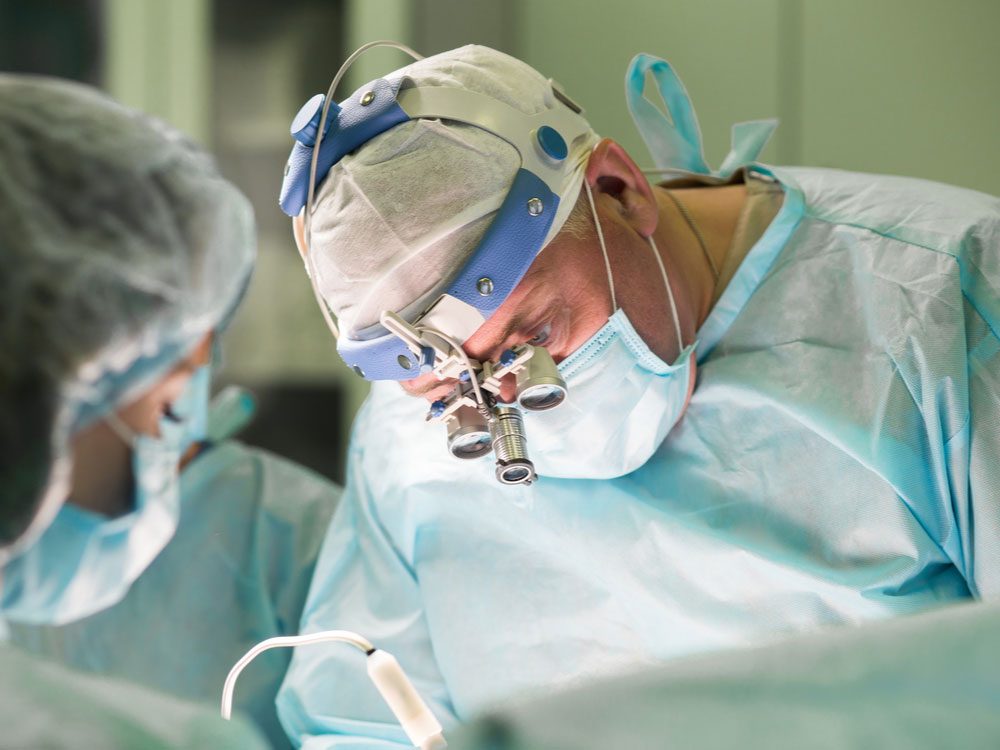
What’s Wrong with Me?
The patient: Robert, 67, a veterinarian
The symptom: Shortness of breath
The doctor: Dr. Thomas Bauer, a thoracic surgeon at Jersey Shore University Medical Center in New Jersey
One morning in May 2014, Robert was attending to a sick mare on a ranch in the U.S. Midwest when the animal lashed out, catching him in the neck with a back hoof. Robert lost consciousness and doesn’t recall the ambulance ride to the ER. He spent several days in the intensive care unit on a ventilator—the blow had fractured the C3 and C4 vertebrae near the base of his neck. The veterinarian’s recovery was slow and painful, and he required a cervical brace to allow his bones to heal.
Here are 22 secrets pain doctors won’t tell you.

The Diagnosis
When he was finally able to return home, a few weeks after the accident, Robert still couldn’t breathe normally. Any exertion left him struggling for air. He couldn’t bend over to lace up his boots and wasn’t able to lie flat, so he slept in a reclining chair. Working was also a challenge, and he had to scale back his practice. At first he thought his shortness of breath would fade as he healed more fully, but when three months had passed since the accident and his condition was no better, he visited his family doctor. Robert was overweight and had diabetes—his doctor told him it was likely his poor general health that was making it difficult to breathe.
Robert, who had been carrying extra weight for a long time, wasn’t convinced that was the problem. Many months after returning home, he was still sleeping in a chair, so he sought a second opinion. After being given the same diagnosis, he tried at least one more doctor and still had no answer. Finally, in the spring of 2016, he convinced a physician to take an X-ray. The test showed that Robert’s diaphragm was elevated and not working properly. When he broke his neck, the nerve roots supplying his phrenic nerve were severed or compromised, causing paralysis of the diaphragm. Doctors told him there was nothing they could do to fix it.
It was Robert’s wife who took to the Internet in search of a better answer. She discovered Dr. Thomas Bauer and his colleague Dr. Matthew Kaufman, a plastic surgeon, who had teamed up to develop a diaphragmatic regeneration program at Jersey Shore University Medical Center. In November 2016, the two doctors reviewed Robert’s medical records and consulted with him remotely.
Every patient should know these 33 hospital secrets.

The Treatment
After considering the options, the team decided on plication, which is a minimally invasive procedure that involves reshaping and repositioning the diaphragm to create more room in which the lungs can expand. “When the diaphragm is elevated, there’s less room for air to move,” Bauer says. “When patients bend over or lie down, the diaphragm goes even higher, making breathing difficult.” Bauer treats patients like Robert who have sustained injuries, as well as those whose diaphragms are paralyzed by tumours, cardiac surgery or progressive disc disease. “We tailor the treatment to each patient,” Bauer says. “Unfortunately, many patients are dismissed because their doctors don’t think they can be helped, but the sooner it’s addressed, the better the outcome, as over time the diaphragm begins to atrophy.”
Robert flew to New Jersey and had the surgery the following day. The procedure lasted an hour and a half, and he remained in the hospital for the next two days before checking into a local hotel. There, he noticed the results of the operation immediately. “Just being able to lie in a normal bed again was a tremendous improvement for him,” Bauer says. Without the surgery, Robert’s breathing problems would have persisted, permanently affecting his quality of life and increasing his risk of developing complications like pneumonia because his lungs weren’t ventilating normally.
A week later, Robert returned for a final follow-up appointment, and his surgeons were pleased with the results. Although he will never breathe as effortlessly as he could before the accident at the ranch, he was so delighted by the results that he vowed to share them with his physicians back home. Robert resumed his veterinary practice—and began once again sleeping horizontally in his own bed.
Here are 12 terrifying mystery illnesses—resolved.